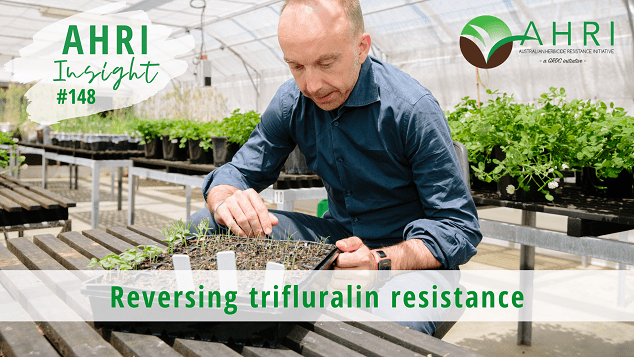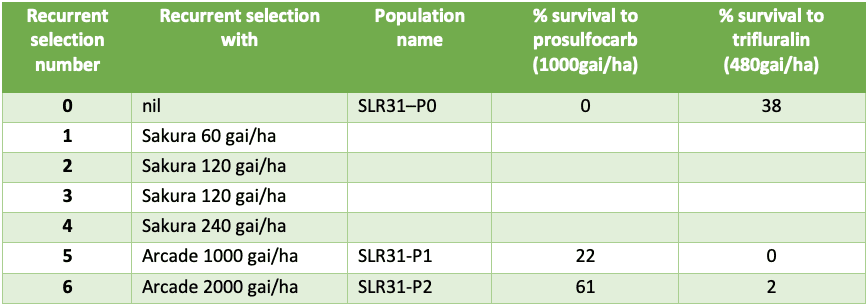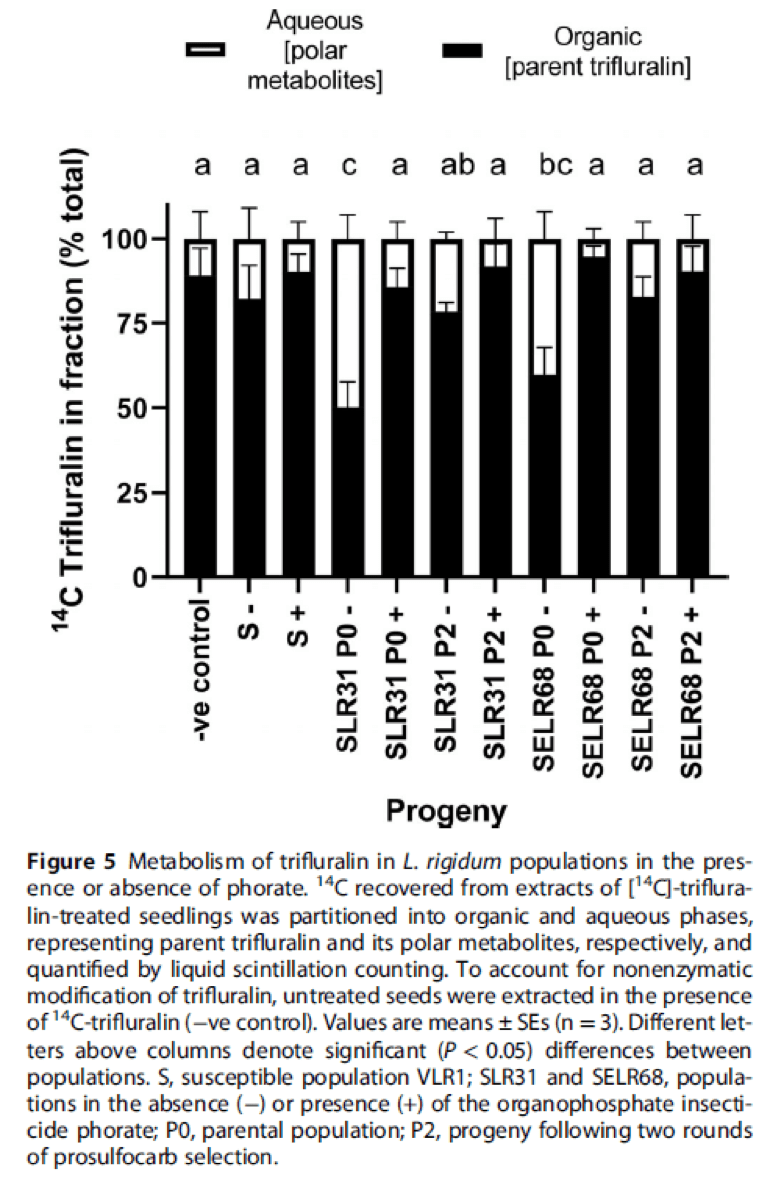
THEY said it couldn’t be done – climbing Everest, flying to the moon and even deep-frying Mars bars. We were also told that we couldn’t reverse herbicide resistance. In the majority of cases the experts are right – herbicide resistance is permanent, and we thought that was the case for all resistant weeds.
Until now…
Australian Herbicide Resistance Initiative (AHRI) researchers, Dr Roberto Busi and Dr Danica Goggin have seen trifluralin resistance disappear in two populations of ryegrass that they were studying. They started with trifluralin resistant ryegrass then they “bred” prosulfocarb resistance using recurrent selection over several generations, and as the ryegrass became more prosulfocarb resistant, it became susceptible to trifluralin. This is called negative cross resistance, and it’s extremely rare.
The researchers suspect that this is due to the P450 enzymes involved in metabolic resistance and more research will confirm this.
What do we do with this information? Should we try and reverse trifluralin resistance in the field by evolving prosulfocarb resistance, or are we better to simply mix trifluralin with prosulfocarb and other pre-emergent herbicides to maximise efficacy and slow the evolution of resistance?
Some of the great discoveries in science are accidental, just as Alexander Fleming discovered penicillin and changed medicine forever, Roberto Busi accidentally discovered reversing trifluralin resistance. It remains to be seen whether this changes herbicide resistance forever!

Roberto has used recurrent selection in the lab to ‘breed’ resistance to several herbicides including pyroxasulfone (e.g. Sakura) and prosulfocarb (e.g. Arcade). Recurrent selection involves spraying a population of ryegrass with a herbicide, then ensuring that the survivors cross pollinate with each other and collecting the seed. In each case at least 100 plants were sprayed and at least 10 survived which were isolated so they could cross only with each other.
This important research has helped us understand the risk of evolving resistance to these herbicides in the field.
The parent ryegrass populations
This research included two parent ryegrass populations.

Breeding herbicide resistant weeds with recurrent selection
SLR31 was selected with Sakura (pyroxasulfone) four times then twice with Arcade (prosulfocarb). These six rounds of recurrent selection resulted in 61 per cent resistance to prosulfocarb at 1000 gai/ha. At the same time, trifluralin resistance dropped from 45pc to 0 – 2pc.

SELR68 was selected twice with Arcade (prosulfocarb) at 500 g/ha of active ingredient (gai/ha). These two rounds of recurrent selection resulted in 30pc resistance to prosulfocarb at 1000 gai/ha. At the same time, trifluralin resistance dropped from 41pc to zero. One selection with prosulfocarb did little to affect the level of prosulfocarb or trifluralin resistance, but the second selection caused a significant increase in prosulfocarb resistance and the population became completely susceptible to trifluralin.

Why is it so?
Now for the difficult task of explaining what we believe is happening here and who better to help than biochemist Danica Goggin. Danica teamed up with Roberto to measure the metabolism of trifluralin as well as study the P450 enzyme activity using the P450 inhibitor, phorate.
Stay with me here, let’s take it one step at a time
- Metabolic trifluralin resistance
One of the main mechanisms of trifluralin resistance is metabolism based resistance by P450 enzymes. We know this because when researchers use a P450 inhibitor such as phorate, they can switch off the resistance. That is exactly what Roberto and Danica did in this study. For example, for the SELR68-P0 population, pre-treating the ryegrass seeds with phorate reduced trifluralin survival from 41pc to 4pc. Turning off the P450s with phorate turned off the resistance.
- Prosulfocarb is a pro herbicide
When prosulfocarb is first taken up by a ryegrass plant it’s not herbicidal. Prosulfocarb must be activated within the plant by a P450 enzyme to become herbicidal. This is what we call a pro herbicide. P450 is short for P450 mono – oxygen – ase (they add one oxygen to a molecule). Once inside the plant a P450 adds an oxygen to prosulfocarb and we have an active herbicide. Other examples of pro herbicides include clomazone and triallate (Avadex).
- Prosulfocarb resistance appears to be due to a lack of P450
If prosulfocarb needs activation by a P450, what happens if these P450s disappear? You guessed it, prosulfocarb doesn’t get activated and it doesn’t work anymore. In this study, Danica and Roberto treated prosulfocarb susceptible ryegrass with the P450 inhibitor phorate, and stopped prosulfocarb from working. The researchers strongly suspect that the absence of one or a number of P450s is what is causing prosulfocarb resistance. This will be the subject of further research.
- How is this linked to trifluralin resistance reversal?
Now time for the high five moment!
What if the P450/s that disappeared from this population to cause prosulfocarb resistance are the same ones that cause trifluralin resistance?
Boom!
I was in Roberto’s office a couple of years ago when he told me this and I high fived him!
This can be a little hard to get your head around, and even harder to explain, so here’s a graphic to try and help clear it up.
We must be clear that this is speculation at this stage and further research is needed to confirm this. However, Danica did study the metabolism of trifluralin in this study using radio labelled 14C trifluralin and found that as prosulfocarb resistance increased through successive generations of recurrent selection, the metabolism of trifluralin decreased.

What should we do with this information?
Firstly, we should be cautious. There’s always another resistance mechanism and this phenomenon is unlikely to happen with every population of ryegrass. For example, we already know of another trifluralin resistance mechanism involving a tubulin target site mutation (see AHRI insight 97 ) and there are likely to be other resistance mechanism that are yet to be discovered.
Secondly, we should all high five Roberto and Danica! It’s a pretty amazing piece of research.
And then what?
Personally, I believe the message is to continue to mix trifluralin with Arcade (prosulfocarb), Boxer Gold (prosulfocarb + metolachlor), Sakura, Avadex, etc. etc. etc. If trifluralin resistance and prosulfocarb resistance are mutually exclusive in a number of ryegrass populations then the mix of these herbicides makes a lot of sense, from both a resistance and efficacy point of view.
Can we reverse trifluralin resistance in the field?
The field will be different to the lab. These studies set up the ideal situation for what we call an ‘arranged marriage’ between ryegrass plants that have survived selection with a herbicide. This is likely to take longer in the field. However, if you have a population of ryegrass that was confirmed resistant to trifluralin, and you have switched to other pre-emergent herbicides for several years, it may be worth testing for trifluralin resistance again. But make sure you test in exactly the same part of the paddock as there’s a lot of genetic diversity in a population.
Summary
Paradigms were made to be broken. We thought that herbicide resistance was always permanent and that a Mars bar would not survive being battered and dipped into boiling oil, but we weren’t to know that AHRI researchers would bust one myth and some hungry, ingenious Scotsmen would bust the other!
Video: Reversing trifluralin resistance
Source: Australian Herbicide Resistance Initiative (AHRI)



HAVE YOUR SAY